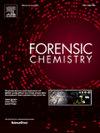Incorporating organic gunshot residue into the forensic workflow: A study of preservation and stability of the pGSR and OGSR
IF 2.6
3区 医学
Q2 CHEMISTRY, ANALYTICAL
引用次数: 0
Abstract
In recent years, trace evidence examiners started to assess the value of incorporating two complementing analytical measurements: primer residue (pGSR) and organic gunshot residue (OGSR) data, aiming to strengthen firearms-related investigations. Still, there is a need to understand the cost-benefit of any method's modification for collecting, analyzing, and interpreting the combined information. This study aims to answer practical questions concerning optimal storage conditions for OGSR and pGSR, the feasibility of sequential analysis on the same sample, and whether pGSR or OGSR should be analyzed first. Samples were collected from shooters (n = 128) using a standard carbon adhesive stub. The stability of OGSR and pGSR was evaluated at the time elapsed from collection at the scene until analysis at the laboratory (1, 2 days, 1, 2 weeks, and 1, 2, 6 months) and storage conditions (room temperature or freezer). The experimental design includes the effect of the analysis sequence by either liquid chromatography-mass spectrometry (LC-MS/MS) and scanning electron microscopy energy dispersive X-ray spectrometry (SEM-EDS) on the detection rates. The results indicate a multi-testing approach does not compromise the integrity of pGSR or OGSR evidence when following appropriate protocols. The detection of OGSR and pGSR is not significantly different at the studied storage conditions or times when samples are preserved in sealed SEM stubs. These findings may alleviate some concerns regarding the feasibility of conducting an OGSR examination on samples that cannot be submitted to the laboratory immediately after collection and assist agencies in establishing preservation, storage, and acceptance criteria for future adoption.

将有机射击残留物纳入法医工作流程:pGSR和OGSR的保存和稳定性研究
近年来,痕量证据审查员开始评估结合两种互补的分析测量方法的价值:引物残留物(pGSR)和有机射击残留物(OGSR)数据,旨在加强与枪支有关的调查。尽管如此,仍然需要了解用于收集、分析和解释组合信息的任何方法修改的成本-收益。本研究旨在回答OGSR和pGSR的最佳储存条件、对同一样品进行序贯分析的可行性、pGSR和OGSR孰先孰后等实际问题。从射击者(n = 128)身上采集样本,使用标准碳粘接短根。从现场采集到实验室分析(1、2天、1、2周和1、2、6个月)和储存条件(室温或冷冻),对OGSR和pGSR的稳定性进行评估。实验设计包括液相色谱-质谱(LC-MS/MS)和扫描电镜能量色散x射线光谱(SEM-EDS)分析顺序对检漏率的影响。结果表明,当遵循适当的协议时,多重测试方法不会损害pGSR或OGSR证据的完整性。当样品在密封的SEM存根中保存时,OGSR和pGSR的检测在所研究的存储条件或时间上没有显着差异。这些发现可能会减轻对不能在收集后立即提交给实验室的样品进行OGSR检查的可行性的一些担忧,并协助机构建立保存、储存和验收标准,以供将来采用。
本文章由计算机程序翻译,如有差异,请以英文原文为准。
求助全文
约1分钟内获得全文
求助全文
来源期刊

Forensic Chemistry
CHEMISTRY, ANALYTICAL-
CiteScore
5.70
自引率
14.80%
发文量
65
审稿时长
46 days
期刊介绍:
Forensic Chemistry publishes high quality manuscripts focusing on the theory, research and application of any chemical science to forensic analysis. The scope of the journal includes fundamental advancements that result in a better understanding of the evidentiary significance derived from the physical and chemical analysis of materials. The scope of Forensic Chemistry will also include the application and or development of any molecular and atomic spectrochemical technique, electrochemical techniques, sensors, surface characterization techniques, mass spectrometry, nuclear magnetic resonance, chemometrics and statistics, and separation sciences (e.g. chromatography) that provide insight into the forensic analysis of materials. Evidential topics of interest to the journal include, but are not limited to, fingerprint analysis, drug analysis, ignitable liquid residue analysis, explosives detection and analysis, the characterization and comparison of trace evidence (glass, fibers, paints and polymers, tapes, soils and other materials), ink and paper analysis, gunshot residue analysis, synthetic pathways for drugs, toxicology and the analysis and chemistry associated with the components of fingermarks. The journal is particularly interested in receiving manuscripts that report advances in the forensic interpretation of chemical evidence. Technology Readiness Level: When submitting an article to Forensic Chemistry, all authors will be asked to self-assign a Technology Readiness Level (TRL) to their article. The purpose of the TRL system is to help readers understand the level of maturity of an idea or method, to help track the evolution of readiness of a given technique or method, and to help filter published articles by the expected ease of implementation in an operation setting within a crime lab.
 求助内容:
求助内容: 应助结果提醒方式:
应助结果提醒方式:


